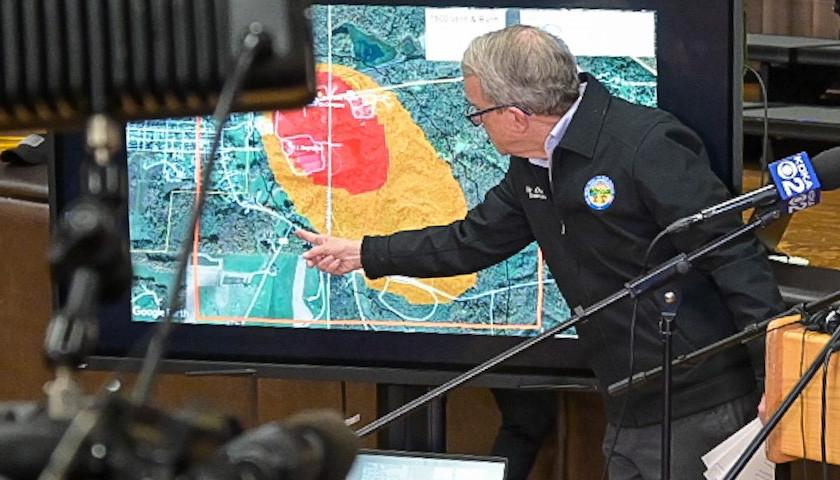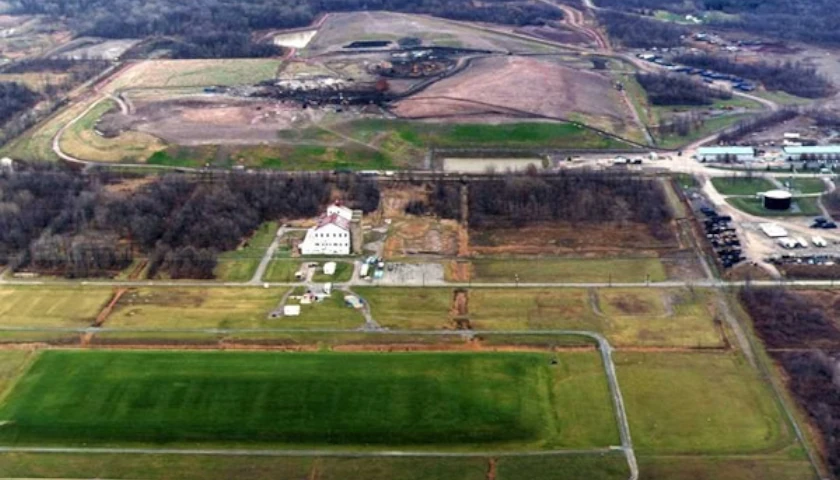Twelve days following the catastrophic train derailment on February 3rd and the controlled release and burn of noxious gasses in East Palestine, Ohio questions still linger about the decisions that were made and who authorized the controlled burn.
A U.S. Environmental Protection Agency (EPA) spokesperson did not directly comment early Monday to The Ohio Star if an On-Scene Coordinator (OSC) was at the East Palestine derailment, or if such an officer may have recommended or authorized the controlled burn.
According to the EPA website, OSC’s are the federal officials responsible for monitoring or directing responses to all oil spills and hazardous substance releases reported to the federal government, and would generally be present in a catastrophe such as the Norfolk Southern train derailment. OSCs coordinate all federal efforts with and provide support and information to, local, state, and regional response communities. In general, an OSC is responsible for the assessment, monitoring, response assistance, and evaluation of a hazardous substance release.
However, EPA Regional Administrator Debra Shore did tell The Star on Monday afternoon that “EPA personnel” were dispatched to the scene immediately upon hearing of the incident.
“As soon as EPA was notified of the Norfolk Southern train derailment on Friday, February 3rd, EPA personnel were on-site by 2 a.m. Saturday morning to assist with air monitoring. Since then, EPA has been boots-on-the-ground, leading robust air-quality testing – including with the state-of-the-art ASPECT plane and a mobile analytical laboratory – in and around East Palestine,” Shore told The Star in an email. ASPECT stands for Airborne Spectral Photometric Environmental Collection Technology.
The Star is also awaiting a reply from the governor’s office, local and regional EPA offices, state environmental agencies, and Norfolk Southern with additional information about the analysis undertaken that resulted in the decision to “vent and burn” the train carriages containing vinyl chloride – as well as the legal authority under which that decision was made.
On February 3rd, 50 train carriages, 10 of which were carrying hazardous materials, derailed as a result of a technical problem with a rail car axle, according to federal authorities. There was vinyl chloride in five of the vehicles.
Exposure to vinyl chloride may cause an elevated risk of lung, brain, and a rare type of liver cancer. When burned it releases hydrogen chloride and the poisonous gas phosgene, which Germans used as a weapon in World War I.
Five train carriages were at risk of exploding due to the unstable vinyl chloride composition, which could have sent fatal shards into the air. Around 3:30 p.m. on February 6th, Norfolk Southern Railroad carried out a controlled discharge of the vinyl chloride to avert an explosion.
In a press conference on Tuesday, Governor Mike DeWine said before deciding to implement the controlled release, he and Pennsylvania Governor Josh Shapiro spoke with representatives from the railroad who recommended that the controlled release was the best option for the safety of the residents.
DeWine also noted that the Ohio National Guard did a modeling exercise of how the release would work in conjunction with the U.S. Department of Defense to give some additional information and understand the full ramifications before making the decision. The modeling was then produced into a map, and the decision was made to proceed with the recommended controlled release.
“We made the decision to go ahead with the controlled release,” DeWine said.
At the press conference, DeWine did not comment on the legal authority he, Shapiro, and the collaborating agencies acted under when ordering the controlled release or any details of the analysis that led to the decision.
But according to a letter from Shapiro to Norfolk Southern on Tuesday, the Pennsylvania governor is seriously concerned with their handling of the train derailment that occurred just a quarter mile from the Pennsylvania state line.
Shapiro claims Norfolk Southern caused confusion by failing to put in place a unified command. He asserted that it disseminated false and contradictory information. Finally, he alleges that the failure to consider alternatives to the vent and burn strategy was what resulted in the plume.
“Norfolk Southern’s unwillingness to explore or articulate alternative courses of action to their proposed vent and burn limited state and local leaders’ ability to respond effectively. As discussed, Norfolk Southern response personnel improperly planned tactical response operations without adequate input from elected officials, local response organizations, or state agencies, resulting in a single plan of action to vent and burn all five cars without allowing for input from Pennsylvania emergency management leaders. Norfolk Southern failed to explore all potential courses of action, including some that may have kept the rail line closed longer but could have resulted in a safer overall approach for first responders, residents, and the environment,” Shapiro said.
– – –
Hannah Poling is a lead reporter at The Ohio Star and The Star News Network. Follow Hannah on Twitter @HannahPoling1. Email tips to [email protected]
Photo “Gov. DeWine at Feb 06 Press Conference” by Gov Mike DeWine.






The vinyl chloride was not burned at a high enough temp thus dioxin was formed. It should not have been burned the way it was. It takes extremely high temps to avoid dioxin formation. Leaving the vinyl chloride in the ditch was a much better option.